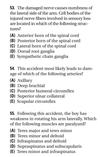[Review test] Upper limb Flashcards
(34 cards)

- C.
- E.
* four branches of thoracoacromial- pectoral
- clavicular
- acromial
- deltoid
- E.
- D
* the long thoracic nerve arises from the roots of the BP (C5-C7)
- D
A 16 year old patient has weakness flexing the metacarpophalyngeal joint of the ring finger and is unable to adduct the same finger. Which of the ff muscles is most likelly paralyzed?
- A. Flexor digitorum profundus
- B. Extensor digitorum
- C. Lumbrical
- D. Dosral interosseus
- E. Palmar interosseus
E. Palmar interosseus
- Dorsal interosseus : abduct
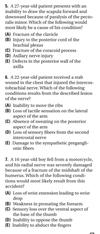
- 5 C
- The pectoralis minor muscle inserts on the coracoid process
- innervated by the medial and lateral pectoral nerves form medial and lateral cords
- 6 D
- arises from the lateral cutaneous branch of the 2nd intercostal nerve
- 7 A
- Radial nerve injury = wrist drop
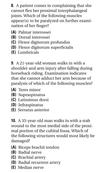
- 8 D
- 9 C
- 10 E
- Components of the cubital fossa (medial to lateral)
- Median nerve
- brachial artery
- biceps brachii tendon
- radial nerve
- Components of the cubital fossa (medial to lateral)

- 11 D
- 12 C
- Muscles attached to the middle digit
- Extensor digitorum
- FDP
- Dorsal interosseus
- lumbricals
- Muscles attached to the middle digit
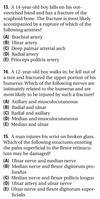
- 13 D
- 14 C
- 15 D
- Structures entering the palm superficial to the flexor retinaculum
- ulnar nerve
- ulnar artery
- palmaris longus tendom
- palmar cutaneous branch of the median nerve
- Structures entering the palm superficial to the flexor retinaculum

- 16 C
- other intrincsic muscles of the thumb inserts in the on the proximal phalanges
- APB
- FPB
- Adductor pollicis
- other intrincsic muscles of the thumb inserts in the on the proximal phalanges
- 17 C
- The median nerves innervates
- 2 LATERAL lumbricals, oppones pollicis,, Abductor pollicis Brevis
- Ulnar nerve
- All interossei, ADDuctor pollicis and 2 MEDIAL lumbricals
- The median nerves innervates

- 18 C
- Ulnar bursa = tendons of both the flexor digitorum superficialis and profundus muscles
- Radial bursa = tendon of Flexor pollicis longus
- 19 A
- Abductors: Deltoid and supraspinatus muscles

- 20 C
- 21 D
A 27 year old baseball player is hit in his forearm by a high speed ball during the world series that form the floor of the cubital fossa appear to be torn. WHich of the ff group of muscles Have lost their fucnctions
- A. Brachioradialis and supinator
- B. Brachialis and Supinator
- C. Pronator teres and supinator
- D. Supinator and pornator quadratus
- E. Brachialis and pronator terer
B
- Lateral boundary is the brachioradialis
- Medial boundary is the pronator teres

- 23 B
- 24 D
- Supinator and the biceps brachii supinates the arm
- 25 D
A Patient with a deep stab wound in the middle of the forearm has impaired movement of the thumb. Examination indicates a lesion of the anterior interosseus nerve. Which of the ff muscles is paralysed?
- A. Flexor pollicis longus and brevis
- B. FPL and OP
- C. FDP and Pronator quadratus
- D, FDP and Superficialis
- E. Flexor pollicis previs and pronator quadratus
C
- supplies the FDL, pronator quadratus and half of the FDP

- 27 C
- the FDP flexes the DIP joints of the index and middle fingers and is innervated by the median nerve
- 28 C
- The ulnar nerve innervates the two medial lumbricals
- 29 C
- The carpal tunner consists of
- Median nerve
- FPL
- FDP
FDS
- The carpal tunner consists of
A man is unable to hold a typing paper between his index and middle fingers. Which of the followinf nerve was likely injured?
- A. Radial nerve
- B. Median Nerve
- C. Ulnar nerve
- D. Musculocutaneous nerve
- E. Axillary nerve
C

- 31 D
- 32 C
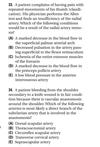
- 33 D
- 34 A
- The suprascapular and transverse cervical artery are branches of the thyrocervical trunk
- Thoracoarcomial artery is a short trunk from the 1st or 2nd part of the axillary artery and has branches
- pectoral
- clavicular
- acromial
- deltoid

- 35 D
- 36 A
- the musculocutaneous nerve contains sympathtetic postganglionic fibers that supply the sweat glands and blood vessels

- 37 E
- 38 D
A 7 year old boy fall from the a tree house and is brought to the emergency department of a local hospital, On examiantion, he has weakness in rotating his arm laterally because of an injury of a nerve. Which of the ff conditions is most likely to cause a loss this nerve function?
- A. Injury to the lateral cord of the brachial plexus
- B. fracture of the anatomic neck of the humerus
- C. Knife wound on the teres major muscle
- D. inferior dislocation of the head of the hunerus
- E. Tumoir in the triangular space in the should region
D
Inferior dislocation may damage the axillary arteries which supplies the deltoid and teres minor
It arises from the posterior cord, and runs through the quadrangular space

- 40 B
- 41 C
- No preganglionic sympathetic GVE
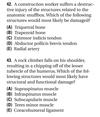
- 42 E
- 43 C
- The subscapularis inserts into the lesser tubercle
- The supraspinatus, infraspinatus, and teres minor inserts on the greater tubercle
A 22 year old female macarena dancer fell from the stage and complains of elbow pain and inability to supinate her forearm. Which of the following nerves are mist likely injured from this accident
- A. Median and Ulnar
- B. Axilalry and Radial
- C. Radial and Musculocutaneous
- D. Ulnar and Axillary
- E Musculocutaneous and median nerves
C
- Supinator is innervated by radial
- Biceps brachii is innervated by the musculocutaneous

- 45 E
- 46 D
- 47 B
A 21 year old man injures his riht arm in an automobile accident. Xray reveals a fracture of the medial epicondyle
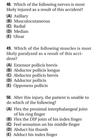
- 48 E
- 49 D
- Ulnar nerve: Adductor pollicic
- Radial nerve: Abductor pollicis longus and extensor pollicis brevis
- Median nerve: Abductor pollicis brevis amd opponens pollicis
- 50 E

